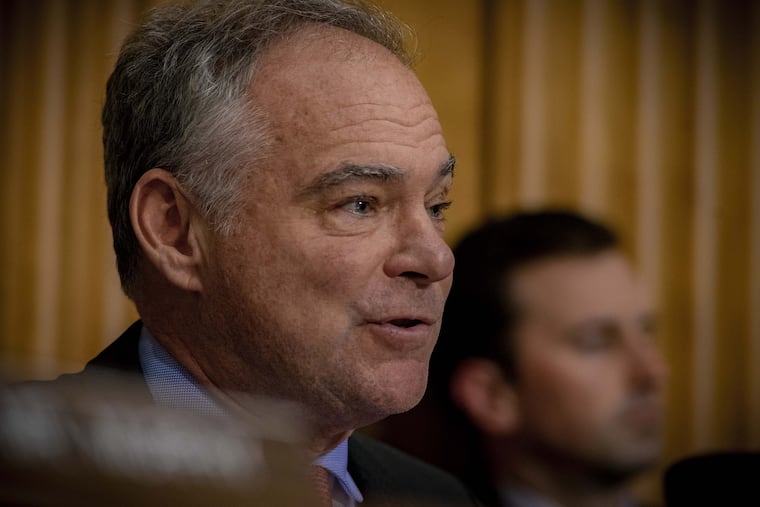Education Department rejects vast majority of applicants for temporary student loan forgiveness program
Lawmakers say the high rejection rate shows the agency is mismanaging the temporary expansion of Public Service Loan Forgiveness, but the Education Department argues that applicants simply are unqualified to receive relief.

WASHINGTON - Tens of thousands of public servants have applied to have their federal student loans forgiven through a temporary relief program run by the U.S. Education Department. Fewer than 300 have had success.
Now, one of the lawmakers who championed the initiative wants to know what happened.
"We authorized $700 million dollars to help ensure public servants - including firefighters, teachers, and nurses - receive the loan forgiveness they have earned, and it's maddening that the Trump Administration is letting it go to waste," Sen. Tim Kaine, D-Va., said in an email.
Kaine and other Senate Democrats have said the Education Department created eligibility criteria that are far more rigid than anything Congress envisioned. The measure in the fiscal 2018 budget that set up the one-time expansion, based on legislation introduced by Kaine and Sen. Sheldon Whitehouse, D-R.I., directed the agency to develop a simple way for borrowers to apply for forgiveness. Instead, lawmakers say the Education Department has restricted access with a litany of rules.
It has been about a year since the Education Department launched the temporary expansion of the Public Service Loan Forgiveness program, with $700 million from Congress to spend over two years. The goal was to give public servants enrolled in the wrong repayment plan another shot at having the balance of their debt erased after 10 years of on-time payments.
In response to an inquiry from Kaine, the Education Department disclosed last week that 38,460 people had submitted requests for forgiveness as of Dec. 28 under the new program. Most, 28,640 people, were immediately rejected because they had not previously filled out a formal loan forgiveness application - one of the many criteria of the relief program.
Of the 9,820 applicants who cleared the first hurdle, 1,184 are still under consideration. The rest were rejected for myriad reasons. Forty percent of the applicants who cleared the initial hurdle still had years to go before hitting the required 10-year mark. Nearly a quarter were ineligible because they were paying less money in the wrong payment plan than they would have in the correct one.
Others were turned away for having the wrong type of federal loan - those originated by private lenders through the now-defunct Federal Family Education Loan Program. Some had not made enough on-time payments or had not had at least 10 years of full-time employment certified by a qualifying employer, according to the department.
"The Department thoroughly evaluates, approves, and denies requests for consideration for Temporary Expanded Loan Forgiveness based on the criteria Congress established," Education Department spokeswoman Liz Hill said in an email.
Only 262 people have jumped through all of the hoops required for their loans to be discharged. A total of $10.6 million in student loans have been forgiven, a small fraction of the $700 million provided to cover canceled loans.
"We're talking about thousands of people who have given a decade of service to our country, and the Education Department is leaving them out to dry," Kaine said Tuesday.
Senate Democrats wrote to Education Secretary Betsy DeVos in June urging her to allow people to submit an application to be processed under the new loan forgiveness program regardless of whether they had already applied for public service forgiveness. The department agreed to the recommendation.
But lawmakers say they've heard from borrowers who had no idea they needed to fill out an earlier application for public service loan forgiveness before requesting forgiveness under the new program, which could account for some of the high rate of rejections. Frustrated borrowers also say they have not received an explanation for the denial of their requests.
The Education Department pushed back against accusations of poor communication with borrowers. Rejection letters contain a list of possible reasons for denial, as does an agency Web page about the temporary expansion initiative, according to the department. The agency said it has turned to social media, hosted a webinar and sent targeted emails to public servants to raise awareness of the program.
Congress carved out money for the temporary expansion after lawmakers said they heard too many stories from constituents about receiving inconsistent and unclear guidance about Public Service Loan Forgiveness.
The earlier program, introduced in 2007 by the administration of President George W. Bush, requires borrowers to be enrolled in specific repayment plans, primarily those that cap monthly loan payments to a percentage of their income. But some borrowers say loan servicing companies led them to believe they were making qualifying payments when they were not.
People have complained to the Consumer Financial Protection Bureau about the company overseeing the program, FedLoan Servicing, processing payments incorrectly or botching paperwork. Those mistakes could lead to additional years of payments or rejected applications. FedLoan has refuted the claims and contended it is working within the confines of the program.
Nearly 99 percent of applications submitted under Public Service Loan Forgiveness have been denied, for many of the same reason the Education Department cited in rejecting requests under the temporary initiative.